【第六十四回目】
蓮玉庵:趣味良し、味良し、上野の蕎麦処
Rengyokuan: Great Soba, Great Tastes
Rengyokuan: Great Soba, Great Tastes
| セインさん。今日は、セインさんの英語学校からも近い上野のお蕎麦屋さんです。江戸時代の後期、安政6年(1859)創業の「蓮玉庵」さん。ご存知でしたか? Thayne-san, today we’ll be going to a soba noodle shop in Ueno, quite near your English school. The shop is called Rengyokuan, and it was founded in 1859. Do you know about it? |
|
| 「はい。時々、お店の前を自転車で通りながら、「格式がありそうな店だなあ」、と気になっていました。でも、ちょっと外国人には入りにくいかな~と。 I do. I sometimes pass by it on my bicycle, and I’ve thought about going in, but I thought it looked quite formal. I think it would be difficult for most non-Japanese to go there alone |
|
| 蕎麦の食べ方がヘタだと怒られそう……とか? Like maybe they would get angry at you for eating soba the wrong way? |
|
| はい。雰囲気を壊したらいけない、と思って(笑) Exactly. I wouldn’t want to ruin the atmosphere! |
|
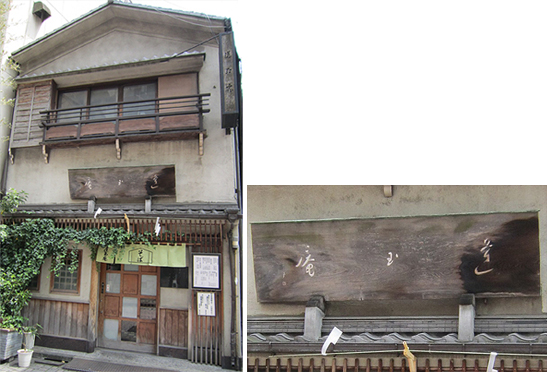 |
|
| じゃあ、入りましょう。 Well, let’s go in. |
|
| (澤島) | こんにちは、セインさん、コンシェルジュさん。蓮玉庵の澤島です。 Hi Thayne-san and Concierge-san, I’m Sawashima of Rengyokuan. |
| こんにちは、澤島さん。今日はよろしくお願いします。 ところで、外観は和風の雰囲気たっぷりなのに、中はとってもモダンなんですね。天井もカーブになっていてかっこいい!浮世絵やアンティークの蕎麦ちょこも飾ってあってギャラリーのようですね。 Hello Sawashima-san, thanks for having us today. I have to say, the outside of your shop just oozes traditional Japanese style, but the interior is quite modern. I like the vaulted ceiling. And the ukiyoe woodblock prints and antique soba bowls make it feel like an art gallery. *http://en.wikipedia.org/wiki/Ukiyoe |
|
| (澤島) | ありがとうございます。この建物は昭和29年(1954)に建てたものですが、創業130年にあたる平成元年(1989年)に大幅に手を入れて新装開店したんです。 Thank you. This building was built in 1954, but in 1989 we reopened the shop after a major renovation. |
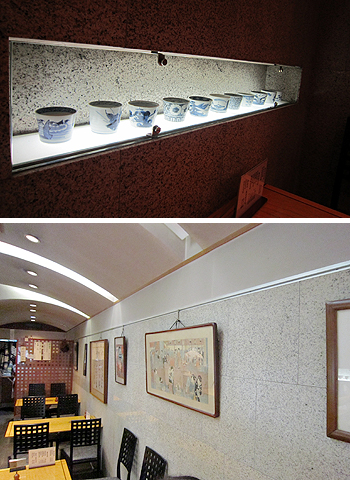 |
|
| 創業は江戸時代だそうですね。 I hear the shop was founded in the Edo Period. |
|
| (澤島) | ええ、正確な創業年はわかっていないのですが、有名な『江戸名所図会』の作者・斎藤月岑(さいとうげっしん)が書いていた日記の1859年11月28日の欄に「蓮玉庵 そばたべる」と書かれているんです。それで、その日を創業日としています。 That’s right. We’re not sure precisely what year, but Saito Gesshin, the author of the famous Edo Meisho Zue, wrote in his diary entry of November 28, 1859, that he was “eating soba at Rengyokuan.” So that’s the date we use for the shop’s founding. *http://en.wikipedia.org/wiki/Edo_Meisho_Zue |
| 実は、斎藤月岑が継いだ斎藤家は将軍家も一目を置いていた神田の大名主なのですが、その家の大番頭・久保田八十八が蕎麦好きで、趣味が高じて不忍池の畔に店を開いたのが蓮玉庵の始まりなんです。でも、そんな身分の人が蕎麦屋をやるのはなかなか許されない事情があって、以前から知り合いだった我が家の先祖・澤島佐助が譲り受けたのだそうです。 Actually, the head of Saito Gesshin’s family was a lord of the Kanda area well-respected by the Shogun, and the head clerk of that family loved soba. In fact, soba became more than a hobby for him and he opened a shop by Shinobazu Pond. That was the beginning of Rengyokuan. However, someone of that high social status could not really be permitted to sell soba as a businessman, and so my family’s ancestor Sawashima Sasuke, who was an acquaintance of his, ended up taking over the shop.*http://en.wikipedia.org/wiki/Shinobazu_Pond |
|
| そして、あとは澤島家が代々受け継いでこられた。ご主人で何代目ですか? And after that, it was passed down generation to generation in the Sawashima family. What generation master are you? |
|
| (澤島) | 6代目になります。 The sixth. |
| やはり、お蕎麦屋さんに生まれると、ある程度の年齢になると蕎麦づくりの修業をさせられるのですか? Being born into a family that runs a soba shop, were you required to study how to make soba when you reached a certain age? |
|
| (澤島) | いや、セインさん。昔の蕎麦屋の主人てのは、そんなに仕事をしなかったんですよ。蕎麦を打つのは蕎麦打ち職人がいるし、茹でるのはまた別の人。みんな、プロフェッショナルなんです。だから、主人は余計な口は出さない。要所要所だけね。ただ、蕎麦つゆだけは主人が作るんです。だから、朝、店に来て、蕎麦つゆを作ったら、あとは任せて種々のお楽しみの場へ出かけていきます。 Actually, not at all. There was a worker to make the soba, and someone else cooked it. Everyone was a professional. So the master didn’t interfere unnecessarily. Only the soba tsuyu (dipping sauce) was made by the master. So every morning the master would come to the shop to make the sauce, but after that he could leave everything to the other workers and visit his favorite hangouts. |
| え?! じゃあ、澤島さんのお父さんも遊んでばかりいたんですか。 Oh, really?! Does that mean your father took it easy? |
|
| (澤島) | そうですよ。先代は若いうちはスキーに登山に浮世絵鑑賞。そのうち俳句をやりだしたらいよい交友関係がひろがって、東都のれん会に加入した関係で歌舞伎に新派、落語に演劇、小説家の人たちとも広く付き合って、遊ぶだけ遊び、飲むだけ飲んで、逝っちゃったよ。 ちなみに、当店の店額は、俳人で作家の久保田万太郎先生の作です。 そうですよ。先代は若いうちはスキーに登山に浮世絵鑑賞。そのうち俳句をやりだしたらいよい交友関係がひろがって、東都のれん会に加入した関係で歌舞伎に新派、落語に演劇、小説家の人たちとも広く付き合って、遊ぶだけ遊び、飲むだけ飲んで、逝っちゃったよ。 ちなみに、当店の店額は、俳人で作家の久保田万太郎先生の作です。 That’s right. When he was young, he went skiing, hiked in the mountains, and enjoyed ukiyoe prints. Eventually he started composing haiku, and his circle of friends expanded. After joining the Toto Norenkai, he met all kinds of people in the arts, including novelists and actors in kabuki,rakugo, and Western and new school theatre. He lived life to the fullest, drank his fill, and then he passed on. By the way, the characters on our shop’s sign were done by the haiku poet Kubota Mantaro. *http://en.wikipedia.org/wiki/Kabuki *http://en.wikipedia.org/wiki/Rakugo |
| でも、それじゃあ、いつ蕎麦つゆの作り方を伝授してもらったんですか? So then when did you learn the art of making soba tsuyu? |
|
| (澤島) | そんなの、後ろからそっと見てたらわかるじゃない。晩年、父親が体を悪くした次の日から、僕が調理場に入ったよ。 All I really had to do was observe my father quietly from behind. In his later years when he fell ill, I took over in the kitchen the very next day. |
| へーっ。 Is that right. |
|
| それで、蕎麦つゆを作り終えたら、お父様同様、遊びに行っちゃって?(笑) セインさん、澤島さんは東都のれん会の中でも趣味人で有名で……というようりも趣味の域を超えているんです。たとえばジャズ。デューク・エリントンだけで270枚ものレコードのコレクションをお持ちだそうですよ。 Once you had made the soba sauce each day, did you go out on the town like your father had? Thayne-san, Sawashima-san is well-known as a man with exquisite tastes, even amongst the Toto Norenkai members. I think you would say many of his interests go beyond being mere hobbies. Take jazz for example: I hear his collection includes 270 Duke Ellington records. |
|
| すごい! Wow! |
|
| (澤島) | はい、彼の音楽も人柄も好きでね。来日すると必ずコンサートを聴きに行きましたし、本を作ったり、いろいろやったよ。 Yes, I loved the man as well as his music. Whenever Duke Ellington toured Japan I always went to his concerts. I also did things like writing books about him. |
| 落語もお好きで、中央大学に入ったら落語研究会がなかったので、ご自分で創設。それが今も続いていて、プロの落語家さんも出しているんだそうですよ。 I also loved rakugo, and when I entered Chuo University they didn’t have a rakugo club at the time, so I started one myself. It’s still around, and I hear some professional rakugo performers got their start there. |
|
| 趣味の域を超えて遊んじゃうのは、血はつながっていないけど、初代からの伝統なんですね。(笑)。 Taking your hobbies seriously may not actually run through your blood, but I can see it’s been a tradition at your shop since the first generation. |
|
| セインさん。では、このあたりでお蕎麦をいただきませんか。 おつまみに、「板わさ」「月見いも」。お蕎麦は何になさいますか…? Well, Thayne-san, are you about ready for some soba? Our side-dishes are “ita-wasa” (fishcakes with wasabi) and tsukimi-imo (“moon-viewing potatoes”). What style of soba would you like? |
|
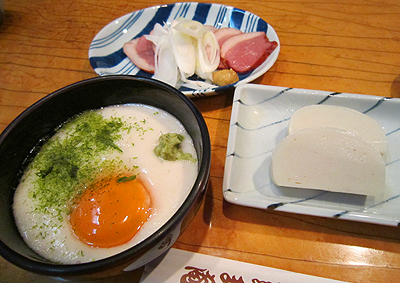 |
|
| 僕はお昼限定の「古式せいろそば 別打ち入り三枚重ね」を。 I’ll have the “old-fashioned seiro soba” lunch special. *http://foodfile.typepad.com/blog/seiro-soba/ |
|
| では私は、同じくお昼限定の「かき揚げそば 小エビと玉ねぎ」をいただきます。 And I’ll have the lunch special―kaki age (mixed vegetable and seafood tempura) soba with shrimp and onions. *http://shizuokagourmet.com/tempura-kakiage-recipe/ |
|
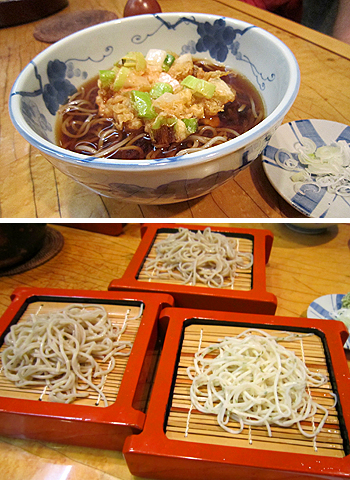 |
|
| 普通の「せいろ蕎麦」も、別打ちの「しそ入り」もおいしいですね。かき揚げもサクサク! 本当においしかった! Both the regular seiro soba and the soba with shiso leaves are delicious. And the kakiage is quite crispy. It’s really good! *http://en.wikipedia.org/wiki/Shiso |
|
| (澤島) | ありがとうございます。実は、今、蕎麦を打っているのは娘なんですよ。 Thank you. Actually, these days my daughter makes the soba. |
| えっ! それはすばらしい! お嬢さんが蕎麦を打って、お父さんが蕎麦つゆを作って、奥様が接客をされて……最高・最強のコンビですね。 Really? That’s great! Your daughter makes the soba, you make the soba tsuyu, and your wife serves the customers. That’s got to be a great team! |
|
| (澤島) | さあ、最高かどうかね(笑)。 Well, I don’t know about that… |
| では、最後に、お蕎麦屋さんとしていつも大事にされてことを聞かせてください。 There’s one last thing I’d like to ask: as a soba shop, what do you consider to be important above all else? |
|
| (澤島) | 蕎麦屋に限らないと思いますけれど、ごまかしのない仕事をする、ということに尽きると思っています。また、それこそが、主人の仕事だとも思っています。 たとえば、素材に妥協しない。業者から「あの店には、変なものを持っていくなよ。うるさいから」と言われるくらいじゃないとだめですよ。 I don’t think this is limited to soba shops, but I think it’s really important to strive to be as honest and sincere in your work as you possibly can. And I think that’s definitely the responsibility of the master. For example, you shouldn’t compromise on ingredients. Suppliers should be saying to themselves, “We’d better not bring them anything of inferior quality or we’ll never hear the end of it.” |
| ああ、いい話ですね。 では、また、お蕎麦を食べにきます! 今日はありがとうございました。 That’s a great philosophy. Thanks so much for your time today. We’ll be back sometime for more soba! |
|
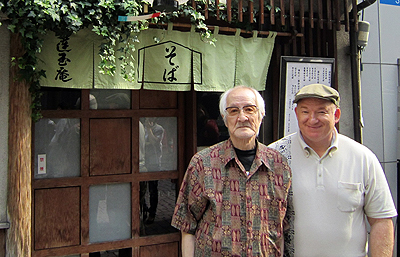 |
|
| (文)太田美代 (英訳)デイビッド・A・セイン |
 1959年、米国生まれ。証券会社勤務を経て来日し、翻訳・通訳など多岐にわたって活躍。豊富な教授経験を生かし、数多くの英語関係書籍を執筆。近著に『日本人のチョットへんな英語』(アスコム)、『超入門シャドーイング』(主婦の友社)、日本人が使いすぎる英語(PHP文庫)など多数。
1959年、米国生まれ。証券会社勤務を経て来日し、翻訳・通訳など多岐にわたって活躍。豊富な教授経験を生かし、数多くの英語関係書籍を執筆。近著に『日本人のチョットへんな英語』(アスコム)、『超入門シャドーイング』(主婦の友社)、日本人が使いすぎる英語(PHP文庫)など多数。下町の魅力に魅了され、自身が代表を務める英語関連のコンテンツ会社のエートゥーゼットのオフィスを根津に構えている。英会話本の執筆をしながら、東京・文京区根津と春日にあるエートゥーゼット英語学校の校長も務める。
http://www.smartenglish.co.jp/
最新記事
This post is also available in: 英語







